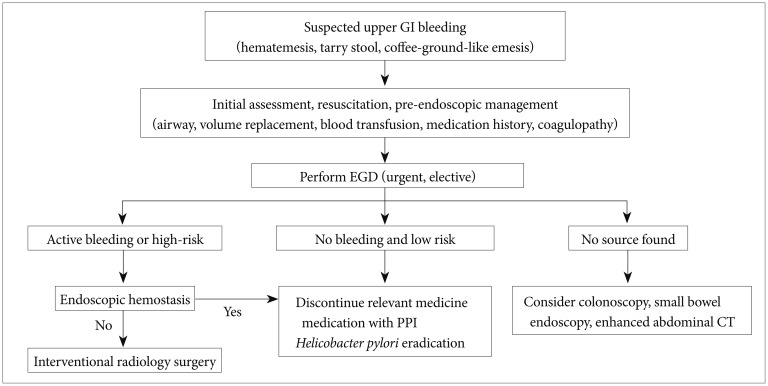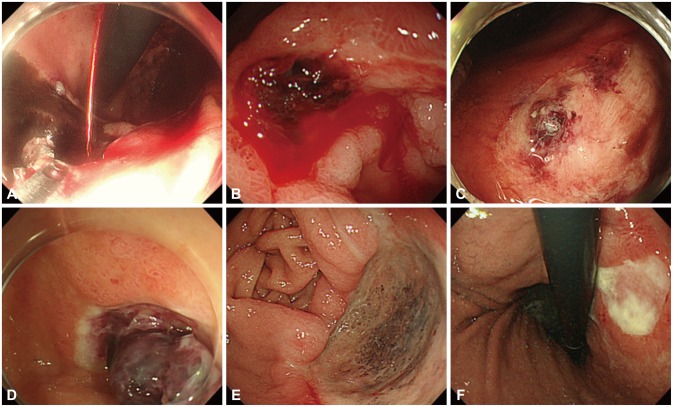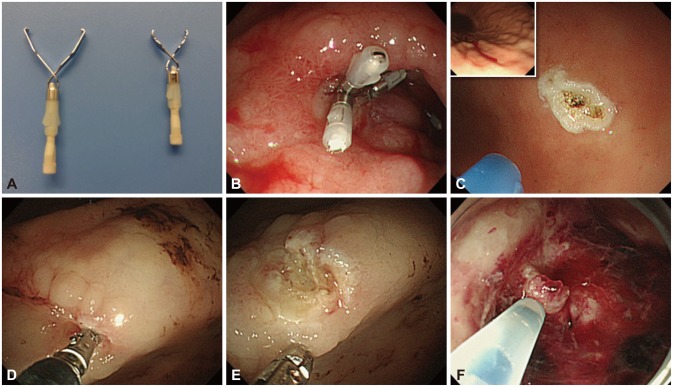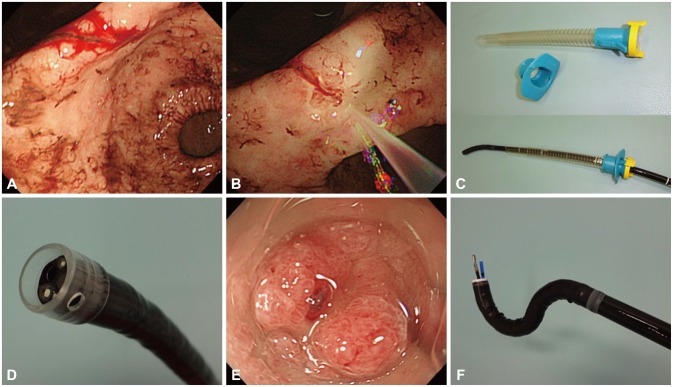Clin Endosc.
2015 Mar;48(2):96-101. 10.5946/ce.2015.48.2.96.
Endoscopic Management of Nonvariceal Upper Gastrointestinal Bleeding: State of the Art
- Affiliations
-
- 1Department of Gastroenterology and Oncology, Institute of Health Biosciences, The University of Tokushima Graduate School, Tokushima, Japan. muguruma.clin.med@gmail.com
- KMID: 1801198
- DOI: http://doi.org/10.5946/ce.2015.48.2.96
Abstract
- Nonvariceal upper gastrointestinal (GI) bleeding is one of the most common reasons for hospitalization and a major cause of morbidity and mortality worldwide. Recently developed endoscopic devices and supporting apparatuses can achieve endoscopic hemostasis with greater safety and efficiency. With these advancements in technology and technique, gastroenterologists should have no concerns regarding the management of acute upper GI bleeding, provided that they are well prepared and trained. However, when endoscopic hemostasis fails, endoscopy should not be continued. Rather, endoscopists should refer patients to radiologists and surgeons without any delay for evaluation regarding the appropriateness of emergency interventional radiology or surgery.
Keyword
MeSH Terms
Figure
Reference
-
1. Bardou M, Benhaberou-Brun D, Le Ray I, Barkun AN. Diagnosis and management of nonvariceal upper gastrointestinal bleeding. Nat Rev Gastroenterol Hepatol. 2012; 9:97–104. PMID: 22230903.
Article2. Barkun A, Bardou M, Marshall JK. Nonvariceal Upper GI Bleeding Consensus Conference Group. Consensus recommendations for managing patients with nonvariceal upper gastrointestinal bleeding. Ann Intern Med. 2003; 139:843–857. PMID: 14623622.
Article3. Sung JJ, Chan FK, Chen M, et al. Asia-Pacific Working Group consensus on non-variceal upper gastrointestinal bleeding. Gut. 2011; 60:1170–1177. PMID: 21471571.
Article4. Al Dhahab H, Barkun A. The acute management of nonvariceal upper gastrointestinal bleeding. Ulcers. 2012; 2012:1–8.
Article5. Hwang JH, Fisher DA, Ben-Menachem T, et al. The role of endoscopy in the management of acute non-variceal upper GI bleeding. Gastrointest Endosc. 2012; 75:1132–1138. PMID: 22624808.
Article6. Rockall TA, Logan RF, Devlin HB, Northfield TC. Risk assessment after acute upper gastrointestinal haemorrhage. Gut. 1996; 38:316–321. PMID: 8675081.
Article7. Blatchford O, Murray WR, Blatchford M. A risk score to predict need for treatment for upper-gastrointestinal haemorrhage. Lancet. 2000; 356:1318–1321. PMID: 11073021.
Article8. Cipolletta L, Bianco MA, Rotondano G, Marmo R, Piscopo R. Outpatient management for low-risk nonvariceal upper GI bleeding: a randomized controlled trial. Gastrointest Endosc. 2002; 55:1–5. PMID: 11756905.
Article9. Lin HJ, Wang K, Perng CL, et al. Early or delayed endoscopy for patients with peptic ulcer bleeding. A prospective randomized study. J Clin Gastroenterol. 1996; 22:267–271. PMID: 8771420.10. Ananthakrishnan AN, McGinley EL, Saeian K. Outcomes of weekend admissions for upper gastrointestinal hemorrhage: a nationwide analysis. Clin Gastroenterol Hepatol. 2009; 7:296.e1–302.e1. PMID: 19084483.
Article11. Lee JG, Turnipseed S, Romano PS, et al. Endoscopy-based triage significantly reduces hospitalization rates and costs of treating upper GI bleeding: a randomized controlled trial. Gastrointest Endosc. 1999; 50:755–761. PMID: 10570332.
Article12. Forrest JA, Finlayson ND, Shearman DJ. Endoscopy in gastrointestinal bleeding. Lancet. 1974; 2:394–397. PMID: 4136718.
Article13. Kim KB, Yoon SM, Youn SJ. Endoscopy for nonvariceal upper gastrointestinal bleeding. Clin Endosc. 2014; 47:315–319. PMID: 25133117.
Article14. Technology Assessment Committee. Chuttani R, Barkun A, et al. Endoscopic clip application devices. Gastrointest Endosc. 2006; 63:746–750. PMID: 16650531.
Article15. Leung Ki EL, Lau JY. New endoscopic hemostasis methods. Clin Endosc. 2012; 45:224–229. PMID: 22977807.
Article16. Hosoe N, Imaeda H, Kashiwagi K, et al. Clinical results of endoscopic hemostasis using a short transparent hood and short hemoclips for non-variceal upper gastrointestinal bleeding. Dig Endosc. 2009; 21:93–96. PMID: 19691781.
Article17. Zepeda-Gómez S, Marcon NE. Endoscopic band ligation for nonvariceal bleeding: a review. Can J Gastroenterol. 2008; 22:748–752. PMID: 18818787.
Article18. Watson JP, Bennett MK, Griffin SM, Matthewson K. The tissue effect of argon plasma coagulation on esophageal and gastric mucosa. Gastrointest Endosc. 2000; 52:342–345. PMID: 10968847.
Article19. Nagata S, Kimura S, Ogoshi H, Hidaka T. Endoscopic hemostasis of gastric ulcer bleeding by hemostatic forceps coagulation. Dig Endosc. 2010; 22(Suppl 1):S22–S25. PMID: 20590766.
Article20. Vergara M, Calvet X, Gisbert JP. Epinephrine injection versus epinephrine injection and a second endoscopic method in high risk bleeding ulcers. Cochrane Database Syst Rev. 2007; (2):CD005584. PMID: 17443601.
Article21. Wu A. Arterial injection of adrenaline causing severe hypertension during emergency gastroscopy. Anaesth Intensive Care. 2013; 41:689. PMID: 23977929.22. Tatsumi K, Uedo N, Ishihara R, et al. A water-jet videoendoscope may reduce operation time of endoscopic submucosal dissection for early gastric cancer. Dig Dis Sci. 2012; 57:2122–2129. PMID: 22451121.
Article23. Dellon ES, Hawk JS, Grimm IS, Shaheen NJ. The use of carbon dioxide for insufflation during GI endoscopy: a systematic review. Gastrointest Endosc. 2009; 69:843–849. PMID: 19152906.
Article24. ASGE Technology Committee. Tierney WM, Adler DG, et al. Overtube use in gastrointestinal endoscopy. Gastrointest Endosc. 2009; 70:828–834. PMID: 19703691.
Article25. Mori H, Kobara H, Fujihara S, et al. Accurate hemostasis with a new endoscopic overtube for emergency endoscopy. World J Gastroenterol. 2013; 19:2723–2726. PMID: 23674883.
Article26. Sumiyama K, Rajan E. Endoscopic caps. Tech Gastrointest Endosc. 2006; 8:28–32.
Article27. Warneke RM, Walser E, Faruqi S, Jafri S, Bhutani MS, Raju GS. Capassisted endoclip placement for recurrent ulcer hemorrhage after repeatedly unsuccessful endoscopic treatment and angiographic embolization: case report. Gastrointest Endosc. 2004; 60:309–312. PMID: 15278071.
Article28. Kim JI, Kim SS, Park S, et al. Endoscopic hemoclipping using a transparent cap in technically difficult cases. Endoscopy. 2003; 35:659–662. PMID: 12929060.
Article29. Isshi K, Tajiri H, Fujisaki J, et al. The effectiveness of a new multibending scope for endoscopic mucosal resection. Endoscopy. 2004; 36:294–297. PMID: 15057677.
Article30. Bjorkman DJ, Zaman A, Fennerty MB, Lieberman D, Disario JA, Guest-Warnick G. Urgent vs. elective endoscopy for acute non-variceal upper-GI bleeding: an effectiveness study. Gastrointest Endosc. 2004; 60:1–8. PMID: 15229417.
Article31. Church NI, Palmer KR. Diagnostic and therapeutic endoscopy. Curr Opin Gastroenterol. 1999; 15:504–508. PMID: 17023997.
Article32. Hearnshaw SA, Logan RF, Lowe D, Travis SP, Murphy MF, Palmer KR. Acute upper gastrointestinal bleeding in the UK: patient characteristics, diagnoses and outcomes in the 2007 UK audit. Gut. 2011; 60:1327–1335. PMID: 21490373.
Article33. Beggs AD, Dilworth MP, Powell SL, Atherton H, Griffiths EA. A systematic review of transarterial embolization versus emergency surgery in treatment of major nonvariceal upper gastrointestinal bleeding. Clin Exp Gastroenterol. 2014; 7:93–104. PMID: 24790465.
Article
- Full Text Links
- Actions
-
Cited
- CITED
-
- Close
- Share
- Similar articles
-
- Endoscopic Management of Nonvariceal Upper Gastrointestinal Bleeding
- Recent Update of Embolization of Upper Gastrointestinal Tract Bleeding
- Endoscopy for Nonvariceal Upper Gastrointestinal Bleeding
- Endoscopy Timing in Patients with Acute Upper Gastrointestinal Bleeding
- Refractory Gastrointestinal Bleeding: Role of Angiographic Intervention





